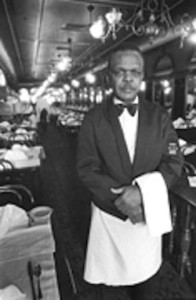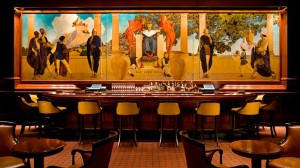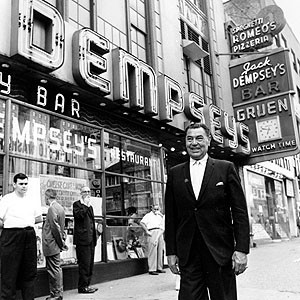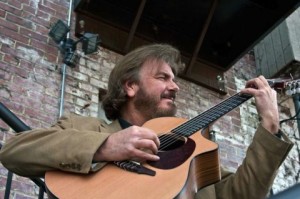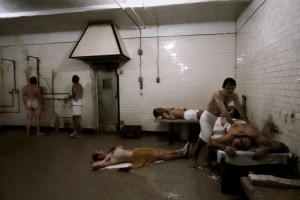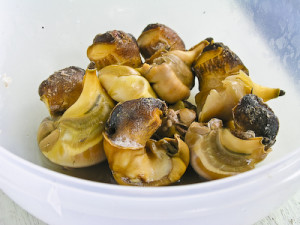In the New York of yesteryear, being a waiter was a profession not just the way-station for actors, models, etc. that it has become. It was a job with which you could raise a family, buy a modest house and lead a life of some dignity. These lifers of the restaurant industry teemed in both ethnic enclaves — Swarthy, smiling Sicilians in Little Italy, surly Jews (“Is the chopped liver good?” “Too good for you”) in the Lower East Side — and some of the older bastions of “Yankee” cooking that were almost exclusively staffed by very dignified, efficient, slightly austere African-American waiters (SJ presumes that this development must have occurred during the “Great Migration” as millions of African American families moved North bringing with them the vastly influential “Low Country” culinary and dining traditions). The late, lamented Gage & Tollner’s in downtown Brooklyn had veteran waiters who had served the old, aristocratic Brooklyn Heights families for decades. The waiters had gold stripes on the sleeves of their jackets denoting their years of service. Lundy’s, on Brooklyn’s Sheepshead Bay, also had dignified African-Americans providing service. Hamburg Heaven, adjacent to Saks Fifth Avenuue, was a favorite of fashionable women. All of the personnel were African-American and casually pleasant. When HG lived in Montclair, NJ., HG often dined at the Wedgewood Cafeteria (closed for many years). It was, even in the 1970s an old-fashioned and gracious establishment much favored by blue-haired ladies and other mature folk. There were many dishes like chicken a la king which did not make demands on people masticating with dentures. The Wedgewood had a unique feature which set it apart from the rough and ready cafeterias like the Belmont, Dubrow’s and others HG frequented in Manhattan: After you ordered your food at the counter, your tray was delivered to your table by a member of the elderly and endearing African American staff who seemed to personally know and care for their aged customers. This made a Wedgewood Cafeteria meal quite an elegant experience.
The African American Waiters Of Old New York
July 13th, 2015 § 2 comments § permalink
Art In Restaurants
July 5th, 2015 § 0 comments § permalink
One of the nice things about living in Santa Fe is the art. Of course, there are scores of galleries (some kitsch but mostly first rate) and a surprising number of museums for a city its size. But, there’s quality art almost everywhere–in banks, restaurants, public buildings, shops, offices, etc. HG’s doctor, for example, has a splendid Dali hanging in her consulting room. One of HG’s favorite spaces is the very good Compound Restaurant on Canyon Road. In an old adobe building, the restaurant was designed by the late Alexander Girard and the sun washed interiors are decorated with a few striking pieces of primitive art. (Girard contributed 106,000 pieces to Santa Fe’s Museum Of International Folk Art). New York has some splendid restaurant art, much enjoyed by HG during HG’s long residence in HG’s once beloved city (now a theme park for the international oligarchy). The now threatened Four Seasons Restaurant in Mies van der Rohe’s Seagram Building has a Lippold sculpture, Bertoia curtains, and a revolving display of paintings by modern masters (The Picasso ballet curtain, alas, has been removed). There is no better place for cocktails than The King Cole Bar in the St. Regis Hotel. (HG/BSK have a special fondness for the hotel since, just abut 52 years ago, the duo had an afternoon reception in the elegant Library room following a morning wedding). King Cole, that merry old soul, is celebrated at the bar with a majestic Maxfield Parrish mural. Gaze at it in wonder as you sip a martini during your next New York visit. But, bring an active credit card. Drinks and snacks are very expensive (but worth it). Another wondrous interior is the Cafe des Artistes (now called Leopard at des Artistes).on W.67th Street. The walls are adorned with frolicking, bare-breasted forest nymphs painted by Howard Chandler Christy. Enchanting. (Some 5l years ago, HG/BSK lived next door to the des Artistes at 27 W. 67th and sometimes popped into the cafe for a drink). The long closed Jams Restaurant introduced Alice Waters-influenced California cuisine to New York. The owners, Melvin Masters and Jonathan Waxman, hung striking modern art on the walls. There are two restaurants with caricatures on the walls–Sardi’s and Palm. Sardi’s features theatrical figures and Palm has Depression era stuff by cartoonists from nearby newspapers (The artists got a free meal). Palm has restaurants throughout the country and has caricatures of local personalities (and good customers) on its walls. When HG resided in Denver, HG often lunched at the Denver Palm outpost at a booth beneath a flattering caricature of HG. Fame.
52 Years of Wonderful Times
July 3rd, 2015 § 4 comments § permalink
July 2, 1963. Fifty two years ago in New York. HG/BSK wed in the Foley Square chambers of Judge George Postel. Wedding brunch at Longchamps on lower Broadway. Sweltering heat wave, but BSK glowed with chic loveliness at HG/BSK’s afternoon reception in the St. Regis Hotel’s elegant Library Room (Bucky Pizzarelli supplied sublime guitar melodies). Dinner that night (with BSK’s family) at Fleur de Lys, little French restaurant near HG/BSK’s 27 W. 67th Street apartment. HG indulged in a platter of heavily garlicked escargots. This caused BSK discomfort as HG secreted pungent waves of garlic in the non-air conditioned apartment. BSK pondered (and not for the last time) whether the marriage was an error. HG/BSK and the marriage survived the evening. Today, on blissful Prince Edward Island, the duo raised breakfast coffee cups and agreed that their long journey together has been very rewarding. Tonight’s anniversary dinner will be a platter of shucked oysters (with BSK’s invigorating shallot vinaigrette), linguine con vongole (loads of little neck clams). Lessons have been learned. Garlic will be handled judiciously. Pecan butter tarts with ice cream for dessert. HG’s wish: Many more years with the love of HG’s life, the lovely, generous, talented, compassionate, sensitive BSK, the best wife, lover, mother, grandmother and companion. And, happily, BSK can cook.
Hoops Magic
May 15th, 2015 § 0 comments § permalink
In HG’s Bronx youth basketball ruled. Sure, there were plenty of softball games, rough and tough sandlot football battles, bleacher seats at Yankee Stadium (to watch the Yanks) and at the Polo Grounds (to watch the football Giants). But, the game that captured the hearts and minds of Bronx guys was basketball. Every Sunday, HG played three-man ball on the asphalt courts of Public School 86 (on Reservoir Avenue) or the Williamsbridge Oval (near Mosholu Parkway). Winning threesome kept the court. Losers left and another trio took their place. First team to score 16 points won. HG was no star. Just a very competitive and fearless journeyman. After games were over, the hungry young men shared huge, greasy pizzas at Joe’s Pizzeria on Jerome Avenue or numerous hot dogs with sauerkraut and mustard at nearby delicatessens. Saturday night was reserved for college games at Madison Square Garden. St. John’s, N.Y.U., C.C.N.Y., Manhattan, L.I.U. all had powerhouse teams and legions of manic fans. Apres game it was off to the Blue Ribbon, a German restaurant, for huge apple pancakes and beer. Currently, HG is watching the NBA playoffs. The players, in HG’s opinion, are the greatest athletes in the world. They combine size, strength, coordination, speed, grace, endurance and a fiery will to win. In recent days HG has seen ferocious, brilliant games culminating in last second heroics by Derrick Rose, Chris Paul, Paul Pierce and Lebron James. Yes, Europeans call soccer “the beautiful game” and Canadians are nuts about hockey…Fuhgeddabout it!! The game that’s got everything is NBA play-off hoops. And, depleted after vigorous TV watching, HG sits down to sumptuous eats prepared by BSK. Beats the hell out of pizza and hot dogs.
Fighter Eateries
May 10th, 2015 § 5 comments § permalink
Recent post on the great heavyweight champ Joe Louis and the New York night club he fronted (Park Avenue Club), has made HG recall the various bars and restaurants of HG’s youth that were named after fighters (the battlers either acted as greeters or were part owners). The most famous was Jack Dempsey’s on Broadway (between 49th and 50th). Really good food. The steaks were outstanding. The ex-heavyweight champ was always on hand, greeting customers and handing out autographed photos. It had a long run (1935-1974) and was professionally managed by co-owner Jack Amiel (He owned the next door Turf Restaurant and his horse, the longshot Count Turf, won the 1951 Kentucky Derby). You can see the restaurant in the movie, “The Godfather.” The art directors did a superb job of reproducing the facade. A bit south on Broadway (1677A Broadway) was Abe Attell’s Cafe. This was more a bar than a full fledged restaurant (had just enough food on hand to satisfy the liquor authorities). Attell, nicknamed “The Little Hebrew”, was a great fighter (featherweight champ with 102 wins to his credit) and all-around scoundrel. He was indicted for aiding Arnold Rothstein in the scandalous “Black Sox” World Series fix but was found innocent by the jury. Big feature of the bar was a colored photo of Abe and opponent Harlem Tommy Murphy–both covered in blood. Abe’s bar was favored by heavy drinking bookmakers and gamblers. Few ate there. Abe himself favored Lindy’s Restaurant a few blocks away. (Broadway gag: “The food is so bad at Attell’s the rats go next door to eat.”) Abe grew up in an Irish neighborhood in San Francisco. Being Jewish, he had to fight in the streets every day. He recalled that he had ten fights in one day. The Attells were a fighting family. Brother Monte Attell, “The Nob Hill Terror,” was world bantamweight champ. First time two brothers were world champs at the same time. The third brother, Caesar, also fought professionally. Good. Not great. He was nicknamed “Two-and-a-half” because that’s what he always tossed in the hat for charitable causes. Further north on Broadway was Benny Leonard’s Cocktail Lounge (corner of 72nd Street). The lightweight champ’s place had a very brief life. Sugar Ray’s Restaurant on Seventh Avenue in Harlem had a longer run and served good food. A.J. Liebling, the eminent journalist who often wrote about boxing, reported that the big, tender pink pork chops he devoured there were mighty tasty. Middleweight champ Sugar Ray Robinson was a man of style. His colorful Cadillac convertible was often parked in front of the restaurant and was much admired. Henry “Hurricane Hank” Armstrong, one of the greatest fighters in history (he held the featherweight, lightweight, welterweight titles at the same time) also opened a Harlem restaurant, Melody Lounge. Bright lights and jazz music weren’t for Armstrong. He closed Melody Lounge and after retiring from boxing became a Baptist minister and youth counselor. Heavweight contender Tami Mauriello had a red sauce Italian restaurant, Tami’s Corner, in the Belmont section of The Bronx. HG recalls eating some splendid sausage and pepper sandwiches there. The best of the fighter associated restaurants was Lew Tendler’s Tavern in Philadelphia. Lew was an esteemed lightweight battler (More than 170 fights with only ten losses). Lew was considered to be the best fighter never to have won a championship and Philadelphia fight enthusiasts are still angry over the injustice. Tendler’s was a raucous, raffish place filled with gamblers, entertainers, Italian and Jewish gangsters. On nights of big fights it was the traditional gathering place of sports writers, HG ate there twice when HG was in Philly aiding in sports coverage. Like Tendler, the food was Jewish: Matzo ball soup. Chopped liver. Huge, garlic smothered tenderloin steaks. Like Sammy’s Romanian in New York but more restrained when it came to chicken fat. When a fight was on TV, gamblers gathered at the bar and wagered on every round. The gambling action was so frantic the sporting guys would forget to order drinks. The bartender, Lew’s son, would turn off the TV. “No money on the bar. No TV.” The bar was soon smothered in green. The New York bar favored by fighters and managers was the Neutral Corner on Eighth Avenue. The most mannerly and quiet bar HG ever frequented.
Chicken Curry Highs and Lows
May 1st, 2015 § 0 comments § permalink
BSK made chicken curry last night and it was a knockout. The basic recipe was based on the curry Vikram Vij, the master of Indian/Fusion cuisine, makes for his family. BSK tweaked his cookbook recipe (more ginger, no garam masala, no cloves, lots of marjoram ). BSK cooks the chicken thighs with their bones. Adds more flavor. When HG began going to restaurants in the 1950’s there were very few Indian restaurants in New York. “Curry Hill” did not exist. The East Village curry joints did not exist. If there was delicious Indian food in Jackson Heights, Queens, HG did not know about it. HG first tasted chicken curry at Longchamps (long closed New York chain of excellent upscale restaurants). This was a suave dish with a slight amount of heat. HG devoured it with delight. When HG/BSK began their marriage, BSK used the Michael Field recipe for chicken curry. The late Michael Field was the author of unerring recipes. Follow the recipe and you couldn’t go wrong. The Field curry was rich (sweet cream was an ingredient) and called for a variety of condiments–chutney, peanuts, coconut flakes, bacon, sliced scallions, etc. Worst curry HG ever tasted was at La Coupole, the famous brasserie on Montparnasse in Paris. La Coupole has a magnificent art deco interior but, unfortunately, serves assembly line food. The touted lamb curry was a gristly, tasteless disaster. London is the go to city for Indian food. Loads of cheap Indian cafes and a variety of plush and posh restaurants. The cheap joints are very good and the expensive eateries are a revelation (Chutney Mary is an HG/BSK favorite).
Joy And Sadness
April 21st, 2015 § 0 comments § permalink
A wonderful musical evening at the home of Polly B. and David F. — delightful, life enhancing friends and neighbors. In attendance was guitarist Marc Yaxley and vocalist/percussionist Julie Hawkins who sang and played for the assembled crowd from Tesuque, Jacona and Santa Fe. HG/BSK nibbled excellent cheeses and drank red wine as the beautiful sounds reverberated off the spacious living room’s adobe walls. Yaxley is one of the country’s best guitarists and he showed the instrument’s versatility by playing everything from Spanish and Mexican classics to Charley Parker and Duke Ellington jazz compositions. (Yes, the guitar is capable of illuminating early bebop). An HG neighbor told the food authority he was planning a trip to New York City and wanted to eat in some Greenwich Village eateries that had retained the old bohemian ambiance of the Village. HG recommended two places specializing in Spanish cuisine—El Faro on Horatio Street in the West Village and El Charro on Charles Street. Similar menus–chorizo, paella, seafood in garlicky green sauce. A heavy hand with garlic. Savory pork chops and fried chicken. Platters of saffron rice. Big pitchers of cheap sangria. HG/BSK enjoyed many festive evenings in these joints. When HG returned home from the music, HG looked up these restaurants on the internet because old time dining venues are increasingly vulnerable to the New York real estate monsters. Sadness. El Faro has been closed for some two years. Located in a very old building, El Faro was fighting a losing battle with mice and was shut down by the city’s health inspectors. The good news is that El Charro still flourishes. HG/BSK will round up some family members when next in New York and dine there. Sangria and smiles are anticipated.
The Baths
March 3rd, 2015 § 0 comments § permalink
During the 1950’s when HG was busy combining careers as a journalist and Broadway press agent, HG would often overindulge in strong drink. (BSK maintains this tendency has not wholly disappeared). The favorite boozing venue of HG and his raffish pals was Moe Dubiner’s bar/restaurant (long closed) on Stanton Street in the Lower East Side. When Moe shuttered his joint at 4 AM, the vodka and whiskey stoked group would often visit the nearby Second Avenue Russian Baths. Immigrant Jews believed in the health benefits of a good “shvitz” (sweat) so the Lower East Side had many bath houses but the Second Avenue was acknowledged as the best (the last remaining Bath House in the LES / East Village is Tenth Street’s Russian and Turkish Baths). HG followed a strict ritual at the Second Avenue. First, a visit to the Eucalyptus Room. Here, HG lounged in dry heat as herbaceous aromas wafted through the room. Then, a warm soapy shower. Into the Russian Room. Six rows of bleacher like marble seating. Hot steam. Macho guys like young HG sat on the very top row where the steam was blazing hot. Sweat poured off HG. Wandering through the room were the attendants/masseurs, hefty fellows clad only in jock strops. They carried bunches of birch branches. HG would beckon and an attendant would swing the branches through the air, sending a stream of hot air to a designated part of HG’s body. After being poached and losing pounds of water (vodka ?), HG would leap into the ice plunge. Yes, it was what it sounds like. A pool of ice cold water. Young HG managed to survive the shock to his system. Then, HG would stand against a wall (protecting his private parts) while an attendant directed a stream of warm water from a high pressure hose at every part of HG’s body. (Some older gentlemen oped for a “high colonic” or a “low colonic”, an internal cleansing. No details. You don’t want to know). HG would shower and then repeat the ritual: Dry heat, steam heat, ice plunge, high pressure hose, shower). The attendants also offered a “playtzeh”, a vigorous, painful massage. HG tried it once. Sheer masochism. After all the steaming and showering, HG picked up a cotton nightshirt and robe and slept a peaceful eight hours in the bath house dormitory. Awakened with an appetite like a ravenous beast. Fortunately, the Second Avenue served a hearty breakfast buffet: Many varieties of herring, smoked whitefish, boiled potatoes, sliced tomatoes and onions, sour cream, cream cheese, cottage cheese, rye bread, pumpernickel bread, bialys, bagels, onion rolls. Coffee. Tea. And, the thoughtful management provided a few bottles of brandy and chilled vodka. All of this took place in the era before bath houses became boy-meets-boy hangouts of the gay community. The Second Avenue was relentlessly heterosexual and ethnic. HG would leave the Second Avenue sober, rested, clear headed …and very, very clean.
“Where The Finest Jews Eat”
March 1st, 2015 § 2 comments § permalink
For many years that was the motto of Moskowitz & Lupowitz, a Romanian-Jewish restaurant on Second Avenue and Second Street in New York. It was a favorite of Groucho Marx, Milton Berle, Eddie Cantor, Sid Caesar and other theatrical luminaries. It was founded in 1909 by Romanian immigrants and for many years was owned and managed by Louis Anzelowitz until finally closing in 1966. It was one of HG’s favorite New York restaurants, offering a robust array of artery clogging traditional Eastern European Jewish dishes. (The loud Sammy’s Romanian on Chrystie Street is the last of the Romanian Jewish restaurants on the Lower East Side. Its menu is a pale shadow of the wonders once offered by M & L). When HG was a child M & L loomed large in HG’s imagination as he often heard their catchy jingle being sung by the Pincus Sisters on the Yiddish language radio station WEVD (named after socialist Eugene Victor Debs). M & L was the classiest Lower East Side restaurant with waiters in tuxedos and thickly carpeted floors. Despite the elegant atmosphere, it was never very expensive. In 1940 you could have a five course steak dinner for $1.35 (fruit juice, appetizer, soup, main dish, dessert). In 1962 you could have this meal for about $4.50. HG’s cardiologist would not have approved of HG’s typical M & L meal: Brains, sweetbreads, chicken livers or chopped liver with chicken fat and onions as an appetizer. This was followed by chicken soup with “kreplach” (meat filled dumplings). Main course was an M & L specialty: “Mushk” steak (rib steak) with “kasha varnishkes” (buckwheat groats with Farfalle pasta, fried onions and chicken fat.) Dessert was an afterthought: Stewed prunes (for digestive purposes). HG drank vodka with the appetizers, beer with the main course and Slivovitz (plum brandy) as a digestif. Plus Russian tea (strong black tea with a spoonful of cherry jam). HG often went to M & L with a stylish girl friend who ordered four appetizers as a meal (they had to be brought in succession by the waiter who grumbled as he made trips to the kitchen). The lady washed them down with Wild Turkey bourbon on the rocks. Pre-World War Two Lower East Side had many “Romanian broilings” restaurants. When little HG accompanied his father to that neighborhood to buy HG a winter outfit (heavy plaid mackinaw, corduroy knickers, cap with attached earmuffs) the two often would visit these joints to lunch on broiled “karnezelach” (beef, garlic and onion cigar-shaped hamburgers) with crisp “silver dollar” potatoes. At night, these places would transform and often featured a violinist playing Yiddish and Gypsy melodies. Italian mobsters and their Jewish gangland associates loved these rough and ready eateries. They were known as “Jew joints.” The bad guys never patronized Moskowitz & Lupowitx. Too classy. Too bourgeois. A “carpet” joint.
Scungilli
February 27th, 2015 § 0 comments § permalink
The dictionary defines scungilli as “a large marine whelk or conch eaten as food.” Yes, this was a protein–in the form of salad or mixed with pasta smothered in super-hot red sauce–that was served in many old fashioned New York Italian restaurants during HG’s youth. The sea creature was pronounced “skoonjeel” and was delicious. Scungilli mostly disappeared from Manhattan menus and soon could be found in only two restaurants in Little Italy–traditional Vincent’s and upstart Umberto’s. In HG’s opinion the best fiery scungilli pasta dishes were found in a tiny Italian joint in Chinatown (corner Mott and Pell). HG ate there with two rugged Goodfellas who solicited HG’s promotional advice on how to improve sales at their legitimate front –a Staten Island furniture store. (Of course, scungilli was always available in Brooklyn, the Corona and Howard Beach neighborhoods of Queens and in the beloved Belmont Tavern, Belleville, New Jersey). Scungilli had its big moment of fame when gangster Crazy Joe Gallo was murdered at Umberto’s Clam House on April 7, 1972. (Scungilli, presumably, was on the table when he met his end.) Crime analysts have wondered why Gallo was dining at Umberto’s rather than the more traditional Vincent’s. HG has a theory: Joe was sentimental and his father, also a gangster, was named “Umberto.” Recently, a hungrygerald.com follower informed HG that there’s a very good Italian scungilli restaurant in Vero Beach, Florida. HG will keep it in mind if he ever ventures into Jeb Bush territory.
